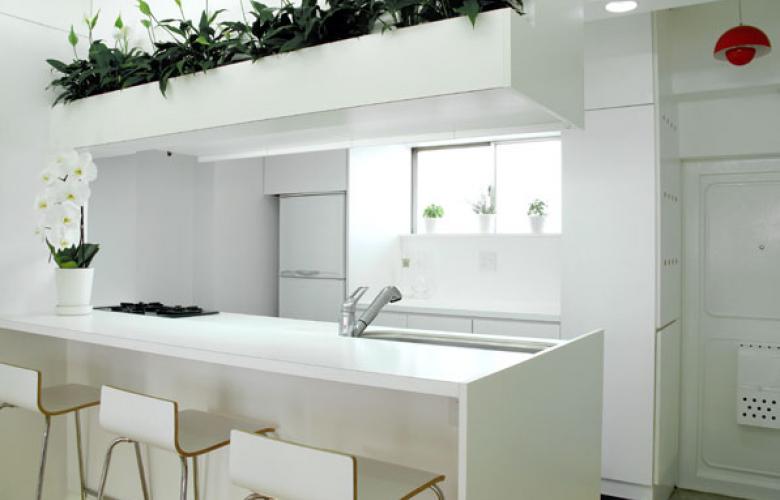Space comes at a premium in Tokyo. Tokyo is one of the most densely urban areas in the world, which led to the birth of eel’s nest narrow houses or the Metabolism architectural movement with coffin-like, single-room apartments that have an almost dystopian air to them. In Japanese culture, there has also never been as much of an emphasis on individual space as there is in Western culture. With cultural principles guided by frugality and moderation, even many Japanese homes in the countryside have rooms smaller than most Westerners would prefer. Homes in Japan are designed to be a shared private space for the family as a unit, not for each individual family member. This is also reflected in the danchi movement that saw the sprouting of modern apartment blocks in the 1960s with a 1LDK layout, consisting of one bedroom and a living/dining room, fit for a small family.
Here are 10 tips to make the most of typical Tokyo apartment with small rooms, less space and low ceilings.
Interior design for small apartments
Keep it light
Light colours serve small rooms well as they optically expand the space. So keep your walls white and choose light colours for your floors. This can also be extended to furniture, especially to larger pieces like a sofa or bed.
Use pops of color
Splashes of colour on an overall light color theme of your apartment can inject some life into it. Try decorating within one color palette (only hues or red or blue), but it sparingly. Key items could be a matching throw and pillows in the living room or a carpet under the coffee table.
The only way is up
Most Japanese apartments also have low ceilings, which makes rooms appear even smaller. Draw the eye up and stretch the space. This works by using wall art or wallpaper elements with vertical stripes. Place this on just one wall or in one corner rather than on all walls. Another trick is to hang pictures and wall art slightly higher up than what you are used to.
Choosing the right furniture
Multi-functional rooms require multi-functional furniture
Space is scarce, so choose multifunctional furniture. This can include sofas and beds that offer storage space inside, coffee tables that offer a storage compartment underneath or nesting tables so you can keep it compact when you are by yourself and pull the smaller tables out if you are having guests over.
Choose foldaway items
With the same idea in mind, foldaway furniture is a great choice for small apartments. Foldaway chairs can be stored in the closet or on the balcony when you don’t need them, a Murphy bed that folds up into the wall might be worth considering, or side tables that can be folded away when they aren’t needed.
Buy Japanese furniture brands
You will find plenty of multi-functional furniture with hidden storage spaces and foldaway items in Japanese furniture stores. Additionally, the dimensions are generally more suitable for a standard Japanese apartment, so follow the old ‘When in Rome’ rule and consider a Japanese sofa or cabinet over an imported one if space is an issue. Popular chains that offer reasonably priced furniture are Nittori and Muji.
Less is more
It can be tempting to buy a number of small furniture items like several chairs, small side tables or storage boxes. However, this can lead to a cluttered look. It might be more advisable to rather purchase only a few large–or right-sized items–for your apartment to avoid this.
Solving the storage problem
First and foremost, store your stuff
Marie Kondo has been preaching this to the world in her books and on Netflix — and she's right. Find a place for each and every of your belongings. Use the built-in oshiire (Japanese closet) that almost all apartments in Tokyo come with and other storage space, like the multi-functional furniture discussed above to keep things out of sight. Reducing clutter and clear surfaces make your space appear organised and like it is large enough to accommodate everything.
Use your balcony
Most Japanese homes come with a balcony, which is generally used by the locals to dry their laundry or even as the space for the washing machine. However it doesn’t need to stop there. You can use it as a storage space for seldom used items like luggage if you weatherproof them by simply covering them. Or consider turning your balcony into a small urban garden — as long as mosquitos don’t proliferate too much in your neighbourhood.
If you are in a shoe box, think outside the box
Your Japanese apartment might simply not allow for the traditional set-up you are used to from back home. Think outside the box to use your space optimally: This could be buying a loft bed so that the space underneath can be used as a closet, considering a foldaway Murphy bed, or foregoing the sofa and instead placing a luxurious armchair in a corner of your living/dining room.
By Mareike Dornhege
Similar to this:
Japanese furniture retailers: Embracing the aesthetic
When East meets West: The contradictions and concessions of the modern Japanese home
Making a house a (typical) home in Japan





